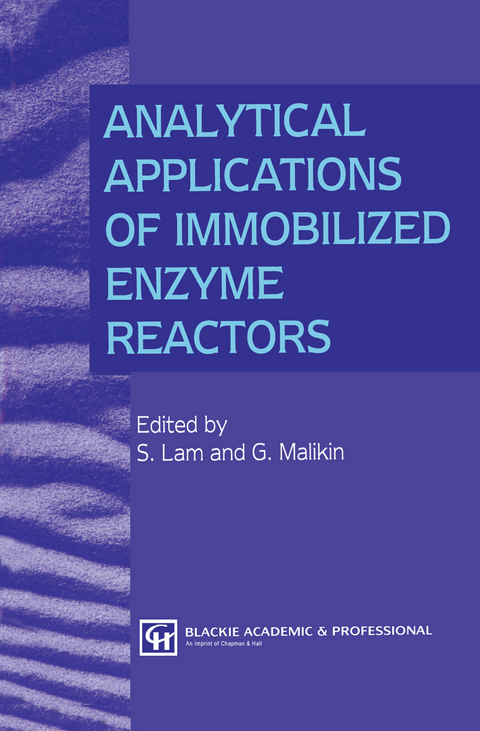
Analytical Applications of Immobilized Enzyme Reactors
Chapman and Hall (Verlag)
978-0-7514-0026-7 (ISBN)
Enzymes are bio-catalysts which effect transformation of substrates to products with high specificity. The usage of enzymes in domestic and industrial applications is well known and has been well documented since the early history of civilization. With the advances in understanding of enzymology, usage of enzymes in industrial and biotechnological pro cesses and molecular medicine has proliferated. One of the key factors in the widespread application of enzymes in modern technologies is the development of enzyme immobilization tech niques, which overcome certain practical, functional and economic con straints. Many natural enzymes can be stabilized by immobilization on solid matrices, with most of the activity retained, for a variety of applica tions. An important application of immobilized enzymes is in liquid chromatography. In the last decade, post-column enzyme detection has become established as an important discipline in liquid chromatography. The new detection approach offers more sensitive and specific ways for measuring major classes of biomolecules. Reactors are fabricated by packing the immobilized enzymes into small columns, which can be placed immediately after an HPLC column.
1 Immobilized enzyme reactors: developmental, practical and theoretical considerations.- 1.1 Introduction.- 1.2 Immobilized enzyme reactors (IMERs).- 1.3 IMER configurations.- 1.4 Enzyme kinetics theory.- 1.5 Flow reactor systems.- 1.6 Flow properties.- References.- 2 Flow reaction detection system designs for sugars and amino acids.- 2.1 Sugars.- 2.2 Amino acids.- 2.3 Conclusion.- References.- 3 Analysis of mono-, oligo- and polysaccharides by enzyme reaction detection.- 3.1 Introduction.- 3.2 Significance of carbohydrates.- 3.3 Flow analysis systems.- 3.4 Chromatographic detectors.- 3.5 Enzymes for carbohydrate analysis.- 3.6 Sample pretreatment.- 3.7 Applications.- Acknowledgements.- References.- 4 Uremic toxin analysis with pre- and post-column immobilized enzyme reactors.- 4.1 Introduction.- 4.2 Hypoxanthine, xanthine and uric acid.- 4.3 Creatinine, urea and electrolytes.- 4.4 Conclusion.- Acknowledgement.- References.- 5 Hydroxysteroids analysis by HPLC with semi-specific post-column immobilized enzyme reactors.- 5.1 Introduction.- 5.2 Post-column enzyme detection of hydroxysteroids.- 5.3 Preparation of the immobilized enzyme reactor.- 5.4 Characterization of the enzyme reactors.- 5.5 HPLC of hydroxysteroids.- 5.6 Enhanced chiral resolution of steroid epimers with stereospecific dehydrogenases.- References.- 6 HPLC of bile acids.- 6.1 Introduction.- 6.2 Detection of products of reaction.- 6.3 Preparation of the reactor.- 6.4 Analytical system.- 6.5 Analysis using an immobilized enzyme reactor.- 6.6 Discussion.- References.- 7 Determination of glucuronide and sulfate conjugates.- 7.1 Introduction.- 7.2 Principle of enzyme detection.- 7.3 Immobilization procedure and preparation of IMER.- 7.4 Reaction conditions and considerations.- 7.5 Selectivity, linearity and reproducibility.- 7.6 Detection of products of reaction.- 7.7 Biomedical applications.- 7.8 Conclusions.- References.- 8 Nicotinamide coenzymes: enzyme reaction detection and signal amplification by substrate recycling.- 8.1 Introduction.- 8.2 Glucose-6-phosphate dehydrogenase reactor.- 8.3 Enzyme reactor for signal amplification by substrate recycling.- References.- 9 Determination of blood ethanol with immobilized alcohol dehydrogenase and oxidase.- 9.1 Introduction.- 9.2 Alcohol dehydrogenase reaction.- 9.3 Preparation of reactors.- 9.4 Detection.- 9.5 Analysis of ethanol in blood.- 9.6 Discussion.- 9.7 Conclusion.- Acknowledgement.- References.- 10 Miscellaneous applications with immobilized enzyme reactors.- 10.1 HPLC of aldehydes with enzyme reaction detection.- 10.2 Trace analysis of zinc by immobilized metalloenzyme reactors.- References.- List of abbreviations.
The editors, both experts in the field, succeeded in finding 18 co-authors who published numerous papers in the area of immobilized enzyme reactors. The result is a monograph with important practical information for those who want to use this type of chemistry in combination with liquid chromatography...a valuable tool for those developing new applications. - Journal of Chromatography; Overall, this book presents a very useful and well referenced introduction to the use of IMERs in chromatography. - Analyst; ...well written and accessible to the non-specialist...this is a well produced book, with a good number of illustration and references and a clear typeface...A useful reference book if you already use IMER technology, and equally useful if you are not a user but want to know more and get up to speed in this area. - Chromatographia
| Erscheint lt. Verlag | 30.9.1994 |
|---|---|
| Zusatzinfo | XII, 276 p. |
| Verlagsort | London |
| Sprache | englisch |
| Maße | 155 x 235 mm |
| Themenwelt | Medizin / Pharmazie ► Medizinische Fachgebiete ► Pharmakologie / Pharmakotherapie |
| Studium ► 2. Studienabschnitt (Klinik) ► Pathologie | |
| Naturwissenschaften ► Chemie ► Analytische Chemie | |
| ISBN-10 | 0-7514-0026-2 / 0751400262 |
| ISBN-13 | 978-0-7514-0026-7 / 9780751400267 |
| Zustand | Neuware |
| Haben Sie eine Frage zum Produkt? |
aus dem Bereich


